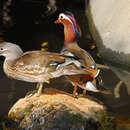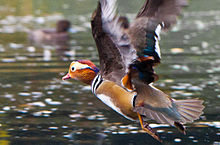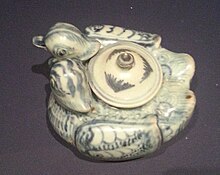en
names in breadcrumbs


The Mandarin is held in high esteem by the Japanese and the Chinese. In these countries, they serve as a symbol of happiness and marital fidelity.
Perception Channels: visual ; tactile ; acoustic ; chemical
Derstruction of habitat has had a severe impact on the oriental populations of Mandarins. In 1911, the Tung Ling forest, a Mandarin stronghold, was opened up for settlement and thereafter forests were cleared. By 1928 few sufficient breeding areas remained. The current Asian population may be under 20,000 birds. One factor that has helped the Mandarin to survive is their bad taste. These ducks are not hunted for food.
IUCN Red List of Threatened Species: least concern
They have been exported to the west, namely Britain, since 1745. They are bred in captivity by European avicultururalists.
The Mandarin Duck's basic diet consists of water plants, rice and other grains.
The Mandarin duck breeds in eastern Siberia, China, and Japan and winters in southern China and Japan. There is a small free-flying population in Britain stemming from the release captive bred ducks.
Biogeographic Regions: palearctic (Native ); oriental (Native )
The Mandarin lives in the forests of China and Japan. They prefer wooded ponds and fast flowing rocky streams to swim, wade, and feed in.
Terrestrial Biomes: forest
Aquatic Biomes: lakes and ponds
In full plumage, the male has a pair of "sail" feathers that are raised vertically above the back, a crest of orange and cream feathers, and a broad white eye-stripe that is bounded above and below by darker feathers. The female is duller in color and has an overall grey appearance marked by a curving white stripe behind the eye and a series of white blotches on the underparts. In flight, both sexes display a bluish-green iridescent speculum.
Range mass: 428 to 693 g.
Other Physical Features: endothermic ; bilateral symmetry
Mandarin courtship display is very impressive and includes mock-drinking and shaking. Pairs are formed at the beginning of the winter and may continue for many seasons. Although the female chooses the exact nesting site, the male accompanies the female on nest searches. Nest are alway in a hole in a tree and can be up to thirty feet from the ground. In preparation for egg laying, the female lines the nest is with down. Clutch sizes range from nine to twelve white oval eggs that are laid at daily intervals. Incubation is solely performed by the female and last between 28 and 30 days. When all the eggs are hatched (they hatch within a few hours of each other), the mother calls to the chicks from the ground. Each chick then crawls out of the hole and launches itself into a free fall. Amazingly, all the chicks land unhurt and are en route to the nearest feeding ground. Once the chicks are able to fly (after 40-45 days), they leave to join a new flock.
Range eggs per season: 9 to 12.
Key Reproductive Features: iteroparous ; gonochoric/gonochoristic/dioecious (sexes separate); sexual ; oviparous
The mandarin duck (Aix galericulata) is a perching duck species native to the East Palearctic. It is sexually dimorphic; males showing a dramatic difference from the females.[3] It is medium-sized, at 41–49 cm (16–19 in) long with a 65–75 cm (26–30 in) wingspan. It is closely related to the North American wood duck, the only other member of the genus Aix. 'Aix' is an Ancient Greek word which was used by Aristotle to refer to an unknown diving bird, and 'galericulata' is the Latin for a wig, derived from galerum, a cap or bonnet.[4] Outside of its native range, the mandarin duck has a large introduced population in the British Isles and Western Europe, with additional smaller introductions in North America.
The adult male has a red bill, large white crescent above the eye and reddish face and "whiskers". The male's breast is purple with two vertical white bars, the flanks ruddy, and he has two orange feathers at the back (large feathers that stick up similar to boat sails). The female is similar to the female wood duck, with a white eye-ring and stripe running back from the eye, but is paler below, has a small white flank stripe, and a pale tip to its bill.[5]
Both the males and females have crests, but the purple crest is more pronounced on the male.
Like many other species of ducks, the male undergoes a moult after the mating season into eclipse plumage. When in eclipse plumage, the male looks similar to the female, but can be told apart by its bright yellow-orange or red beak, lack of any crest, and a less-pronounced eye-stripe.
Mandarin ducklings are almost identical in appearance to wood ducklings, and very similar to mallard ducklings. The ducklings can be distinguished from mallard ducklings because the eye-stripe of mandarin ducklings (and wood ducklings) stops at the eye, while in mallard ducklings it reaches all the way to the bill.
Various mutations of the mandarin duck are found in captivity. The most common is the white mandarin duck. Although the origin of this mutation is unknown, the constant pairing of related birds and selective breeding is presumed to have led to recessive gene combinations, leading in turn to genetic conditions including leucism.
The species was once widespread in East Asia, but large-scale exports and the destruction of its forest habitat have reduced populations in eastern Russia and in China to below 1,000 pairs in each country; Japan, however, is thought to still hold some 5,000 pairs. The Asian populations are migratory, overwintering in lowland eastern China and southern Japan.[6]
Specimens frequently escape from collections, and in the 20th century, a large, feral population was established in Great Britain; more recently, small numbers have bred in Ireland, concentrated in the parks of Dublin. Now, about 7,000 are in Britain with other populations on the European continent, the largest of which is in the region of Berlin.[7] Isolated populations exist in the United States. The town of Black Mountain, North Carolina, has a limited population,[8] and a free-flying feral population of several hundred mandarins exist in Sonoma County, California. This population is the result of several ducks escaping from captivity, then reproducing in the wild.[5] In 2018, a single bird, dubbed Mandarin Patinkin, was seen in New York City's Central Park.[9]
The habitats it prefers in its breeding range are the dense, shrubby forested edges of rivers and lakes. It mostly occurs in low-lying areas, but it may breed in valleys at altitudes of up to 1,500 m (4,900 ft). In winter, it additionally occurs in marshes, flooded fields, and open rivers. While it prefers fresh water, it may also be seen wintering in coastal lagoons and estuaries. In its introduced European range, it lives in more open habitat than in its native range, around the edges of lakes, water meadows, and cultivated areas with woods nearby.[6]
Compared to other ducks, mandarins are shy birds, preferring to seek cover under trees such as overhanging willows, and form smaller flocks,[10] but may become bolder as a result of becoming tame from frequent interaction with humans.

In the wild, mandarin ducks breed in densely wooded areas near shallow lakes, marshes or ponds. They nest in cavities in trees close to water during the spring. A single clutch of nine to twelve eggs is laid in April or May. Although the male may defend the brooding female and his eggs during incubation, he himself does not incubate the eggs and leaves before they hatch. Shortly after the ducklings hatch, their mother flies to the ground and coaxes the ducklings to leap from the nest. After all of the ducklings are out of the tree, they will follow their mother to a nearby body of water.[6]

Mandarins feed by dabbling or walking on land. They mainly eat plants and seeds, especially beech mast. The species will also add snails, insects and small fish to its diet.[11] The diet of mandarin ducks changes seasonally; in the fall and winter, they mostly eat acorns and grains. In the spring, they mostly eat insects, snails, fish and aquatic plants. In the summer, they eat dew worms, small fish, frogs, mollusks, and small snakes.[12] They feed mainly near dawn or dusk, perching in trees or on the ground during the day.[6]
Predation of the mandarin duck varies between different parts of its range. Mink, raccoon dogs, otters, polecats, Eurasian eagle-owls, and grass snakes are all predators of the mandarin duck.[12] The greatest threat to the mandarin duck is habitat loss due to loggers. Hunters are also a threat to the mandarin duck, because often they are unable to recognize the mandarin in flight and as a result, many are shot by accident. Mandarin ducks are not hunted for food, but are still poached because their extreme beauty is prized.[12]


The Chinese refer to Mandarin ducks as yuanyang (simplified Chinese: 鸳鸯; traditional Chinese: 鴛鴦; pinyin: yuānyāng), where 'yuan' (鴛) and 'yang' (鴦) respectively stand for male and female mandarin ducks. In traditional Chinese culture, mandarin ducks are believed to be lifelong couples, unlike other species of ducks. Hence they are regarded as a symbol of conjugal affection and fidelity, and are frequently featured in Chinese art.
A Chinese proverb for loving couples uses the mandarin duck as a metaphor: "Two mandarin ducks playing in water" (simplified Chinese: 鸳鸯戏水; traditional Chinese: 鴛鴦戲水; pinyin: yuānyāng xì shuǐ). A mandarin duck symbol is also used in Chinese weddings because in traditional Chinese lore, they symbolize wedded bliss and fidelity. Because the male and female plumages of the mandarin duck are so unalike, 'yuan-yang' is frequently used colloquially in Cantonese to mean an "odd couple" or "unlikely pair" – a mixture of two different types of same category. For example, the drink yuanyang and yuan-yang fried rice. Mandarin ducks featured on the flag of Weihaiwei during British rule.
For Koreans, mandarin ducks represent peace, fidelity, and plentiful offspring. Similar to the Chinese, they believe that these ducks mate for life. For these reasons, pairs of wooden-carved mandarin ducks called wedding ducks are often given as wedding gifts and play a significant role in Korean marriage.[13]
Similarly, in Japanese the ducks are called oshidori (おしどり/オシドリ/鴛鴦) and are used in the phrase oshidori fūfu (おしどり夫婦, "a couple of lovebirds/happily married couple"). In addition, the Crown Prince wear the Sokutai decorated with a pattern features oshidori.
Portrait of a male at Martin Mere, England
Drake in eclipse plumage
Drake during moulting prior to eclipse plumage
Egg, Museum Wiesbaden collection
A male in Łazienki Park, Warsaw
A male mandarin and a female mallard in Stara Iwiczna, Poland
A pair of incense boxes shaped like mandarin ducks
A male mandarin duck in Central Park, New York
The mandarin duck (Aix galericulata) is a perching duck species native to the East Palearctic. It is sexually dimorphic; males showing a dramatic difference from the females. It is medium-sized, at 41–49 cm (16–19 in) long with a 65–75 cm (26–30 in) wingspan. It is closely related to the North American wood duck, the only other member of the genus Aix. 'Aix' is an Ancient Greek word which was used by Aristotle to refer to an unknown diving bird, and 'galericulata' is the Latin for a wig, derived from galerum, a cap or bonnet. Outside of its native range, the mandarin duck has a large introduced population in the British Isles and Western Europe, with additional smaller introductions in North America.